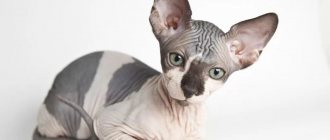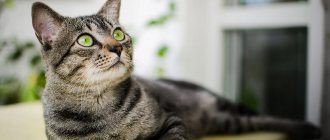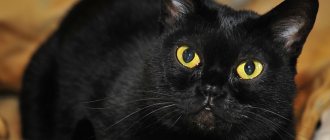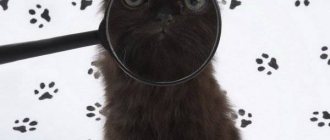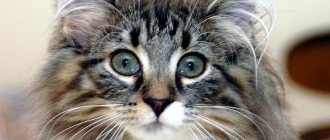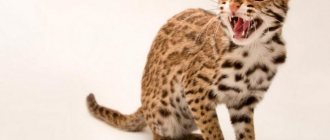The Asian tabby is a unique breed, let’s look at the rules of caring for it in detail and look at the tabby color. Whatever pet you get, you will still love it, take care of it and be happy that a dog or cat welcomes you home after a hard day at work. The main advantage of pets is sincere love for the owner, which is simply impossible not to notice.
If you decide to get an Asian tabby, remember that you should pay special attention to its maintenance. To begin with, please note that you will need to buy only high-quality feed. They should be selected in accordance with the pet’s lifestyle and place of residence. Even when choosing food, we recommend that you first consult with a veterinarian; he will select an option that does not provoke the development of diseases.
Tabby cat on the street
In addition, you need to take care in advance to ensure that your home is safe. Remove all sharp objects so that the cat does not damage its limbs, provide a separate place for it to eat, rest, and go to its own toilet. If you are a first time owner, ask your veterinarian for help.
History of the breed
The Asian tabby cat appeared in the 80s. last century in Great Britain. Local felinologists tried to cross a Persian cat with a Burmese cat. The appearance of the born kittens included the silky fur of the Persian and the massive bones of the Burmese.
At the next stage of selection, the Abyssinian breed was involved. And a few years later, at an exhibition in London, experts presented a new cat breed with special characteristics. In 1990, felinologists gave a detailed description of its characteristics, as a result of which the Asian tabby was officially recognized.
Now the Asian shorthair cat is common only in Great Britain and some European countries. And in the Russian Federation and the USA, the tabby breed is still practically unknown.
We recommend reading about the Burmese cat
Colors
The color of the Asian shorthair is interesting. The four most common colors are:
- Marble;
- Spotted;
- Ticked;
- Brindle.
Marble
The marbled color is very symmetrical. Its main feature is stripes on the sides in the form of a spiral. We can say that they are somewhat reminiscent of patterns that intersect and form one continuous unusual print.
This color is considered classic, as it is more common than others.
Spotted
The spotted color is manifested by dark spots of different sizes that are scattered throughout the cat's body. The main part of the fur, in this case, should be light.
When compared with other representatives of the cat family, this color is more reminiscent of a leopard
ticked
The most interesting, unusual variety, since one hair has several colors at once: the dark part alternates with the light one. In such cases, the fur is monochromatic.
Tiger (mackerel)
From the name it is clear that the Asian brindle tabby resembles a tiger in its color. The fur itself is a light shade, with dark parallel stripes (vertical) on it (as in the photo).
Brindle color
Interesting fact! Zoologists claim that the mackerel has the same color.
Little leopard
The first scientific name for the miniature owner of beautiful fur was given by the Scottish surgeon Robert Kerr. He translated part of the book “The System of Nature” by the Swedish naturalist Carl von Linnaeus, supplementing it with his own information about some animals. The publication of the publication took place in 1792. Kerr named the new species of forest predator from the cat family Felis bengalensis, or Bengal cat, that is, living in South Bengal. Now this is the territory of India.
In modern classification, the Asian leopard cat belongs to the genus Prionailurus or inhabiting the east. Therefore, small predators have the Latin designation Pr. bengalensis. There are 12 known subspecies of the secretive mistress of the rainforest, the population of which is considered the largest among small carnivores. According to various estimates, it is 150–500 thousand individuals.
Pr. lives on the territory of the Primorsky Territory of Russia. bengalensis euptilurus, or Amur leopard cat. It is listed in the Red Book of this region. Thanks to protection, the number of predators is increasing.
Previously, spotted skins of leopard cats were exported to America and Europe. The scale of destruction of these defenseless animals was enormous. For example, in 1989, there were 800 thousand skins in trading warehouses. Now commercial production has decreased by 16 times, the main buyer is Japan. Fur outerwear is sewn here. Asian leopard cats are freely sold in Bangladesh, India, and Thailand. When environmentalists and police raided the markets of Bangkok, they found 437 dead animals on sale. Since ancient times, local residents have hunted them for meat and used their spotted skins to decorate their homes.
In the United States, the species is considered endangered and special permission is required to import or purchase it. The authorities of China, Indonesia, and Hong Kong took him under protection. The International Red Book includes small groups of individuals living on the islands. But in general, the number of these animals does not raise concerns for conservation.
Burmilla
Burmilla breed history: In 1981, the British breeder of Russian Blue cats Miranada Bickford-Smith (von Krichberg) bought a Persian chinchilla named Jemari Sunquist for her husband. He was supposed to be castrated, but the cat turned out to be more efficient than his owners, and therefore, before the operation, he managed to start an affair with Miranda’s European Burmese - Bambino Lilac Faberge.
As a result, four charming cats of Burmese type and chinchilla color were born. These were the first Burmilla (Burmese chinchilla). Miranda really liked the cats, and she and her friend Teresa Clark (Cartouche) began to develop a new breed. At the same time, Teresa focused exclusively on black chinchilla-colored Burmillas, and Miranda continued to experiment and had a hand in the formation of almost all Asian breeds.
We suggest you read: How to make a terrarium for a land turtle with your own hands
Burmillas were recognized by the GCCF in 1997, and unlike other Asian cats, this breed is recognized by many other renowned show systems. Moreover, in some associations there are also long-haired Burmillas.
Burmilla character: Burmilla are affectionate, friendly and intelligent.
Description of appearance
Males and tabby cats have a strong build and medium size. Moreover, males are slightly larger than females. The weight of adult pets ranges from 4 to 8 kg. The breed from Asia meets the following standards:
- massive body with prominent muscles;
- developed sternum;
- wedge-shaped head with clear outlines;
- wide nose, medium size;
- the ears are erect, large, with rounded tips;
- almond-shaped eyes have a yellowish color;
- the coat is short, there is no undercoat;
- the tail is narrowed towards the end and has a medium length;
- paws of medium size and oval shape;
- the muzzle has pronounced cheekbones.
The Asian Shorthair cat comes in a variety of colors. The most common options:
- Spotted. On the body, in addition to the peritoneum, there are dark spots.
- Mackerel (tiger). The fur has vertical stripes resembling the pattern of a tiger skin.
- Marble. On the back and sides of the animal there are dark stripes and spots that organically intertwine with each other, forming an attractive marble pattern.
- Ticked (agouti). The coat has a single color and only the tail, paws and muzzle have stripes.
However, tabby cats may have white spots on their paws and neck.
What color is a tabby?
They have quite an interesting, non-standard color. There is a ticking effect on the wool. Each hair has several dark areas. Regarding colors, there are only 4 options:
- spotted;
- brindle;
- ticked;
- marble.
The breed is distinguished by the lining around the eyes and the “beads” on the neck.
Health status
Asians are generally in good health, but like all mixed breed cats, they can have some problems. This is due to the genetics that the animal received from all sorts of ancestors. Orientals are characterized by common problems of representatives of the Siamese group:
- Amyloidosis is the deposition of protein in various organs (especially the liver).
- Asthma is a disease of the bronchi.
- Congenital heart defects, such as aortic stenosis.
- Strabismus.
- Gastrointestinal diseases.
- Hyperesthesia syndrome, neurological problems with manifestations in the form of excessive self-care up to the formation of bald patches.
- Lymphoma.
- A neurological disorder that causes involuntary rapid eye movement.
- Progressive retinal atrophy.
It should be remembered that all animals, including absolutely healthy ones, must receive the necessary vaccinations and regular preventive examinations from a veterinarian. Timely medical care will allow pets to live long and happily.
Asian tabby personality
These cats have an extremely friendly and flexible character. Animals interact well with other inhabitants of the house and are able to make friends even with birds and rodents. They will not take revenge on their offenders, do not get into fights with other cats, love to rub against their owner and often sit on his lap.
The Asian kitten quickly adapts to new conditions and gets used to going to the litter box. These pets are highly trainable and can easily tolerate even prolonged loneliness.
We invite you to read about the Kuril Bobtail breed
Kittens play most of the day. They can hide small objects that can be extremely difficult to find. As the animal grows, it becomes calmer, preferring passive rest on a sofa or chair. However, if you don't pay attention to an Asian cat, it can become depressed.
A tabby cat loves home comfort and warmth. These animals have no desire to walk in the fresh air. They can also find something to do at home. Breeders of such pets are recommended to set up play areas for them. You can put several scratching posts, a ladder and a house there.
Walking your pet and favorite place
The Asian tabby is a true homebody. This makes it different from other breeds. They don't need walks on the street at all. On the contrary, it will be much more pleasant for them to spend time with their owner at home, or in a secluded place alone. Therefore, you should not “drag” it into the street.
Since cats of this breed are reclusive creatures that prefer solitude, it is necessary to buy or make a personal home for them yourself. In winter, you can insulate it or simply supplement it with soft pillows.
The cat will be glad if, from the moment of her appearance, the house has not just a separate corner for her, but a whole play complex. In this case, the animal will know where to sharpen its claws, play or just relax. Such house-complexes will protect your furniture from scratching. If it is not possible to equip a personal corner, buy toys for your pet.
Australian Tiffany
Australian Tiffany breed history: Australian Tiffany is the result of the work of Australian felinologists who decided in the 90s. XX century deal with Burmilla kittens with long hair. Since long-haired Asian cats in solid and tortoiseshell colors had already been bred and called Tiffanys, Australians focused on silver and golden animals. These cats became especially popular in the state of New South Wales, where they were first recognized by the local association. In fact, Australian Tiffanys are semi-longhaired Burmilla and Burmoire dogs. However, the Australian Tiffany is distinguished from both of them by a wider head and a more pronounced stop, which makes the latter similar to the American Burmese.
In 1999 the new breed was recognized by the Australian show system.
Australian Tiffany character: Australian Tiffanys are not very active, but they are friendly and unobtrusive.
Bombays and Mandalays are also sometimes classified as Asian cats, but they have a different origin.
External characteristics of Asian smoke cats
First of all, the smoky color of the cat attracts attention to the new breed. Besides that, her movements are simply mesmerizing.
A coat darkened on top with a lighter silvery undercoat creates a shimmering effect.
Australian mist: smoky cat
Description of the smoky cat:
- medium-sized body with well-developed muscles;
- the tail is of medium length, the tip is rounded;
- the head is large with a slightly elongated blunt muzzle;
- weight from 5 to 7 kg (larger cats);
- the ears are straight, set high with rounded tips;
- nose with a depression in the middle, its size is medium;
- the eyes are almond-shaped, widely spaced and golden-green in color;
- The coat is of two types - short and medium length, it is of a uniform smoky color and lies tightly to the skin.
For your information! The smoky color of cats is not the only color. The breed standard stipulates reddish, black, blue, cream and even tortoiseshell colors.
Diseases and life expectancy
Asian cats have excellent health. No predisposition to hereditary mutations has been recorded in this cat breed. The most common causes of deterioration in a pet’s well-being are:
- lack of minerals and vitamins;
- unbalanced diet;
- lack of human communication.
Do not forget about systematic veterinary examinations, deworming and vaccination. If the breed will not be bred, it is recommended that the female cat be spayed or neutered. At the same time, experts note that spayed and neutered pets have an increased tendency to obesity.
With proper care, tabbies can live 15 to 20 years.
History of appearance and description
In 1980, English felinologists decided to crossbreed the two breeds. These were Persian cats and Burmese cats.
As a result of this union, the first kittens appeared, resembling Persians in fur and Burmese in body composition. But scientists did not stop there and added the Abyssinian breed.
What can I say, the experiment was a success. The final result was amazing. Stature, graceful posture, expressive gaze, all these qualities can easily be included in the description of the Asian tabby. This breed took all the best from its parents.
These incredible creatures make you fall in love, even at first sight.
The cat's muscular build gives it a menacing appearance. The paws, of medium length and thickness, do not spoil her at all; on the contrary, when she walks, she moves gracefully.
Temminka
Under this cute name there is a cat. A very unusual color, and not at all related to the “Asian” breed group. Although this individual is Asian. Only wild.
Asian golden cat is what it is called in its homeland. Not related to pets. Large - up to one meter long, weighs 15-17 kilograms.
Has a timid disposition. Mostly, the Asian golden cat can be seen at night. If she doesn't run away when she notices a person.
It feeds on hares and mice. Unfortunately, this animal is being systematically exterminated. Its meat is considered a Chinese delicacy.
Upbringing
The high intelligence of Kurbobs makes their upbringing quite simple. As soon as the kitten gets into the house, he needs to be shown the boundaries of what is permitted, calmly but firmly stopping behavior that goes beyond them. You should stop your pet not with spankings, but simply with a stern call and a word
It is important that he learns the prohibiting command from the first days. It makes no sense to punish and scold a cat for something that was done a long time ago, since he will not understand what caused the owner’s dissatisfaction
In adolescence, Kurbobs begin to try to gain leadership in the family
It is important for the owner to patiently and firmly stop their antics aimed at this. Quite quickly the kitten will understand that he will not be able to take the place of the leader.
If you want, you can train a Bobtail. His high intelligence allows him to quickly master various tricks, which is very valuable especially for families with children. Training should take place in a playful way, otherwise the pet will get bored with it and there will be no results.
Maintenance and care
Shorthaired Asians are extremely easy to care for. However, they require regular hygiene procedures. Breeders of these pets should consider the following care recommendations:
- Wool. Caring for thick and short hair is easy. The animal needs to be brushed at least once weekly. To do this, it is advisable to use a special rubberized glove. During molting, it is recommended to perform treatment every day.
- Ears. The Asian breed needs to have its ears cleaned every day, because... The accumulation of dirt and earwax can cause decreased hearing function in your pet. This should be done with a cotton swab and as carefully as possible. The cotton wool can be pre-moistened with a special solution, which is sold in veterinary pharmacies and pet stores.
- Eyes. Cleaning the eyeballs of an Asian cat should be done as they become dirty. To do this, use a cotton swab treated with warm boiled water. You can also use a special liquid for this purpose.
- Teeth. If your cat is accustomed to cleaning from an early age, you can use a special brush with soft bristles. To eliminate tartar, you need to seek help from a veterinarian. In such a situation, general anesthesia and special devices are used.
- Claws. You can carefully trim them with small scissors or buy special caps. Additionally, it is advisable to purchase a scratching post on which the cat can sharpen its claws.
- Water procedures. The Asian breed has a negative attitude towards water, so it should not be washed frequently. The optimal frequency of bathing is once every 5-6 months or as the coat gets dirty. For water treatments, you need to use specialized shampoos that contain natural ingredients. This is explained by the fact that the skin of Asian women is extremely sensitive and when using low-quality cleaning products, allergic reactions can develop on it.
To avoid problems, it is recommended to purchase all care products and additional accessories at veterinary pharmacies and pet stores. The health of any cat depends both on hereditary tendencies and on the conditions in which it is kept.
Character and behavior
Representatives of the Asian tabby breed are distinguished by their gentle character and good disposition. Animals willingly make contact with people, confirming their friendliness and sociability. Despite their calm nature, Asian tabbies love active pastime and various games.
Cats easily find a common language not only with people, but also with other animals that live in the same territory with them. The breed does not have the habit of holding a grudge and taking revenge. Also, representatives of this species are quite obedient and flexible, and therefore will not spoil the decoration, furniture and other things in the house.
Asian tabbies are highly intelligent and do not require any training. The animal by its nature is extremely restrained, and when communicating with people it shows good manners and tact.
Asian tabbies do not require much attention from others and are quite self-sufficient. This breed is suitable for busy people who don’t have much time to devote to their pet. Cats get along well with children and tolerate their excessive attention.
Asian tabbies love not only their main owner, but also every member of the family. Cats have a hard time with being treated poorly, which can result in mental problems. Animals appreciate the love and care of their owner and happily reciprocate.
It is not recommended to take cats with you on trips or give them foster care to other people. A pet can quickly get used to a new environment and people.
Small kittens are usually more active than adults. Regularity and calmness appear in a cat only with age. The Asian Tabby is an ideal breed to keep at home. These cats are suitable for people of any age.
Price
The price of this cat is completely justified, since the manners and beauty are literally amazing. The value of the graceful beauty is close to $1000. The price varies depending on the place where you purchase this miracle, whether it is a prestigious nursery or secondhand.
Get cats, because this has many advantages, for example, if you live alone, with the appearance of a pet you will no longer be alone, you will be greeted when you arrive home. Also, if you have nothing to do, you will have enough new responsibilities, and you will not waste your time. Also, if a mouse appears in the house, the cat will definitely deal with it.
Sterilization and castration
If you are getting an animal and do not plan to breed it, we recommend spaying or neutering it immediately. Thanks to this, the pet will not suffer at all due to the fact that it cannot continue its family. This is due to the fact that after the operation, sex hormones cease to be produced. Both types of surgery are performed using anesthesia. Surgery should be performed before 1 year of age; the younger, the easier it is for him to undergo surgery and recover. If you have a female, it is best to have her spayed before she gives birth at least once. It will be much easier for her to bear it.
- According to statistics, sterilized animals live several years longer. Moreover, the procedure minimizes the risk of developing diseases such as: oncology of the genital organs;
- polycystic disease;
- hydrometer, etc.
Castration is especially important for males, since cats often suffer serious injuries in the process of “hunting for a female.”
Nutritional Features
A balanced diet is the key to longevity and excellent health of a pet. Therefore, the daily menu of an Asian cat must be rich in vitamins, minerals and nutritional compounds. If your pet will be given natural food, its menu should include:
- cereals;
- fish with bones removed;
- turkey and chicken meat;
- beef meat (lean);
- fruits and vegetables;
- by-products based on chicken or beef;
- milk;
- dairy products.
An Asian cat can be fed dry types of food. However, products should be chosen as high quality as possible. They must contain vitamin supplements, bone meal and natural meat. The following cat foods meet similar requirements:
- EUKANUBA (from 1150 rubles per pack of 2000 mg);
- HILLS SCIENCE DIET (from RUB 890 per 1.5 kg package);
- N&D (from 855 rubles per pack of 1500 mg);
- ACANA (about 1000 rubles per package of 2027 mg).
Synthetic dyes and flavoring additives should not be in the feed, because... they often provoke the development of allergic reactions. Be sure to place a container near the food bowl that will always contain fresh water.
It is forbidden to give Asian cats and cats tubular chicken bones, food from the master's table and sweet foods.
This is interesting: Munchkin: a cat with short legs
Breeding
If you decide to become a breeder, then you simply need to take care of the welfare and health of the cat and kittens. This issue should be approached responsibly, disease prevention should be carried out and an atmosphere of love should be created for pets. In addition, breeders should adhere to the basic rules for knitting cats.
In the future, if the cat plans to give birth, everything should happen in the presence of a doctor or in a veterinary clinic. This way, you minimize the risk of any health problems for your cat or kittens.
Asian tabby prices
It is difficult to find a kitten of the Asian breed on the territory of the Russian Federation. At the same time, Asians rarely appear even at exhibitions.
There are few nurseries in Russia where Asian tabbies are bred, so purchasing such a cat in the country is problematic and costly from a financial point of view.
There are 10 officially registered nurseries in the UK where they breed this exotic cat breed. The cost of one individual varies between $400-600. The registration of the animal and its delivery will cost the same amount.
Mr. Cat Warns: Difference from African Golden Cat and Species
African golden cat Scientists explain some external similarities by convergent evolution; similar characteristics in this case are formed in unrelated groups of animals independently of each other under similar natural living conditions.
In size and color, the animals of both species are extremely similar, only the golden cats living in the central African region have practically no spots in color, only sparse markings on the sides.
The Temminka Cat has three subspecies:
- Catopuma temminckii temminckii live in the Himalayas, Nepal, Malaysia, and Sumatra. These individuals have the shortest coat and a thick, rich reddish color.
- Catopuma temminckii dominicanorum are found primarily in southeastern Chinese provinces.
- Catopuma temminckii tristis - inhabitants of Tibet and the northern regions of Burma.
Catopuma temminckii temminckii
Catopuma temminckii dominicanorum
Catopuma temminckii tristis In China and Thailand, there are many beliefs about this rare animal. It is believed that Temminka's golden hair will protect a hunter from attacks by tigers.
This is connected with the legend of a brave golden cat who single-handedly defeated a huge striped predator.
In many remote villages, in order to scare tigers away from attacking livestock, the fur of the Temminck Cat is still burned in the vicinity of the settlement.
Nevertheless, on the territory of modern Thailand, two Golden Cats were caught and equipped with collars with radio transmitters. Observation of ringed animals made it possible to establish that individuals spend the lion's share of their time in forest thickets and only about 5% in open areas.
How to choose a kitten
Before purchasing a kitten, it is recommended to study the advantages and disadvantages of the breed. When meeting a future family member, you should pay attention to the baby’s activity, the condition of the eyes, ears and fur. It is advisable to personally meet the breeder and learn from him the basic rules of maintenance, feeding and care. And also ask to present:
- pedigree;
- metric;
- veterinary passport;
- green card (if the purchase takes place abroad).
In Russia, it is quite difficult to buy a tabby, and if you are lucky enough to reserve an Asian kitten, a purebred baby will cost the potential buyer between 20,000 and 70,000 rubles.
Where to buy a kitten?
As we said, the Asian cat is not common in Russia. Nevertheless, there are nurseries throughout the country that breed this breed.
In order to purchase a baby, you need to call the breeder in advance and find out when the next litter is expected. The fact is that cats of this breed are rare in Russia. And the litter that is already available can be completely painted. Usually, this is how it is done: kittens are reserved in advance.
After you find out about the plans for the birth of kittens, ask if it is possible to see the parents live. Breeders invite potential owners to visit and meet the cats. There is nothing wrong with this, quite the contrary. A nursery with a good reputation has nothing to hide.
Did you visit the nursery and were satisfied? Now we are starting to prepare to purchase a kitten. The breeder will tell you what you need to buy for your future pet.
By the way, about the price of an Asian cat: focus on the amount of 250-500 euros. Abroad, this is the average cost of a good, purebred baby.
